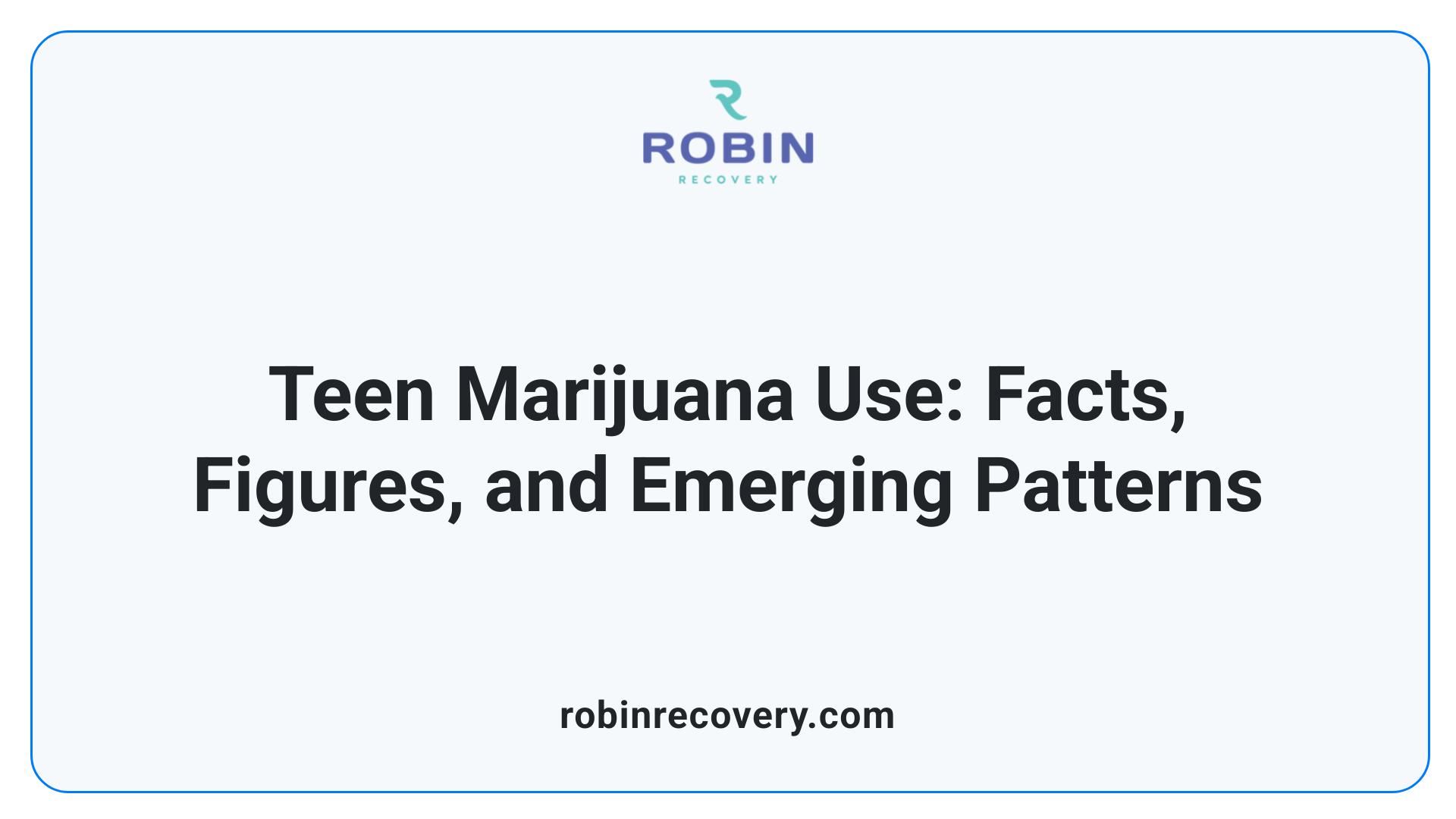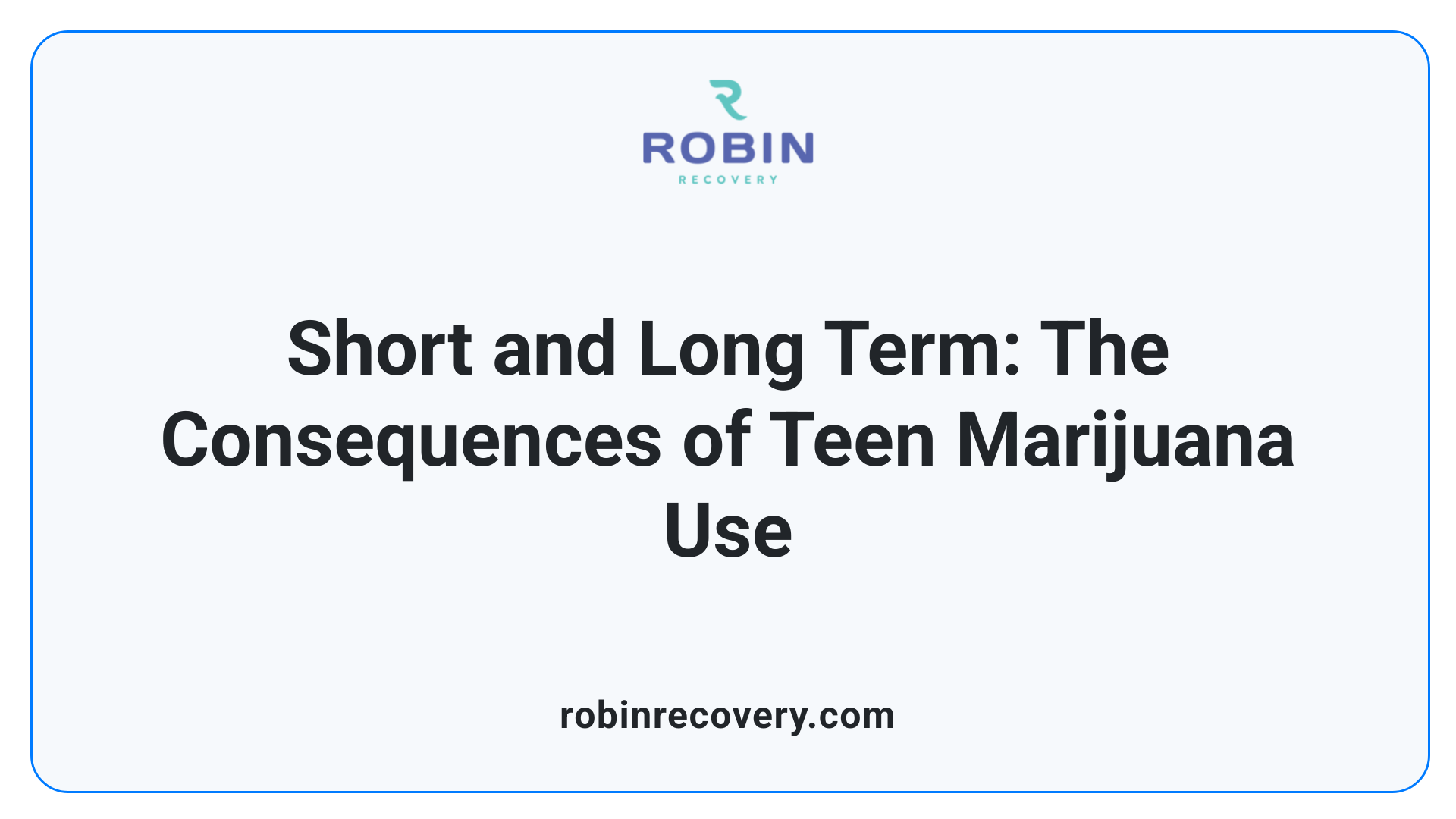Marijuana Use in Teens Is the Cause of Increased Illicit Drug Use

Understanding the Link Between Adolescent Marijuana Use and Illicit Drug Trends
Recent data demonstrates an alarming increase in marijuana use among teenagers, reaching levels not seen in the past three decades. This surge is closely linked to broader issues of illicit drug experimentation and ongoing mental health crises among youth. This article delves into the current statistics, the impact of marijuana on adolescent brain development, motives for recreational use, and its role in fostering wider drug abuse. Emphasizing prevention and education strategies, we aim to shed light on the critical public health challenge posed by teen marijuana consumption.
Current Trends and Statistics in Teen Marijuana Use

What are the current statistics on marijuana use among teenagers?
Recent data reveals that about 15 percent of teens, roughly 1 in 7 adolescents, report using marijuana in the past month. This indicates that marijuana remains the most popular illegal drug among youth, despite legal changes in some areas. In 2022, approximately 30.7% of twelfth graders said they used cannabis in the past year, and around 6.3% reported daily use within the previous 30 days. These figures highlight that a significant portion of teens are experimenting with or regularly using marijuana, which is concerning because of its potential health impacts.
Change in usage patterns over recent years
While teen marijuana use has overall decreased since the late 1990s, current levels are still high compared to historical data. Many teens try marijuana at a young age; nearly 46.6% of high school seniors have experimented with illicit drugs by their senior year. Moreover, the summer months tend to see a spike in first-time use, likely due to increased unsupervised free time and social factors.
Casual use, those who do not develop dependence, makes teens more vulnerable to mental health problems. Studies show that non-disordered users are 2 to 2.5 times more likely to face mental health and behavioral issues than non-users. Importantly, early initiation age correlates strongly with higher risks of developing cannabis use disorder and psychiatric conditions like depression, schizophrenia, or suicidality.
Potency of modern marijuana and its implications
One concerning trend is the increasing potency of marijuana, with today's plants containing two to three times more THC—the primary psychoactive ingredient—than in the 1980s. This higher potency amplifies risks such as psychotic episodes, long-term cognitive impairment, and addiction.
The strong psychoactive effects from high-THC strains can lead to more severe short-term effects, including memory problems, poor concentration, and impaired judgment. Long-term, these can hinder academic achievement, career prospects, and mental health. The rise in potency underscores the importance of awareness and cautious regulation, especially as recreational marijuana becomes more accessible due to legal changes in multiple states.
Aspect Details Implication Usage Rate 15% of teens use monthly; 30.7% of 12th graders (2022) Persistent high usage Recent Trends Increase in initiation during summer Elevated risk periods THC Levels 2-3x higher than past decades More potent effects and health risks Legal Status Recreational use legal in 22 states (as of 2023) Increased accessibility
Overall, these evolving patterns point to the importance of continued research, education, and prevention efforts to address the complex issues surrounding teen marijuana use.
Impact of Marijuana on Adolescent Brain Development

How does marijuana affect adolescent brain development?
Marijuana use during adolescence can significantly interfere with normal brain development because of its high THC content. THC, the main psychoactive element in cannabis, affects areas of the brain responsible for reasoning, memory, judgment, and problem-solving.
During the teenage years, the brain is still maturing, especially regions linked to executive functions. When teens consume marijuana regularly, this can impair these critical cognitive processes. As a result, teens may experience difficulty learning new information, remembering things, and making sound decisions.
Modern cannabis strains are much more potent than those in previous decades. With THC concentrations now two to three times higher, the risk of dependence and long-lasting mental health effects has increased.
Studies show that early use—particularly before age 14—is linked to a higher chance of developing cannabis use disorder and experiencing mental health problems such as anxiety and depression. Cannabis can also alter brain reward pathways, making teens more susceptible to other substance use later in life.
Impairments are not limited to cognition and mental health; marijuana also affects reaction times, coordination, and judgment. These impacts raise safety concerns, especially related to driving or operating machinery.
As legalization expands across states, parents, educators, and policymakers must be aware of these risks. Delaying marijuana use until adulthood and increasing awareness about its effects can protect adolescents from long-term brain development issues.
Motives for Marijuana Use Among Teens

What are the primary motives for teens using marijuana recreationally?
Teenagers choose to use marijuana for a variety of reasons, often influenced by their perceptions of safety, their emotional needs, and social environments. One common motive is to cope with stress, anxiety, or feelings of depression. Studies indicate that about 18% of teens who use marijuana cite using it as a means to forget their problems or to escape emotional discomfort.
Accessibility also plays a significant role. Approximately 14% of teens report that marijuana's ease of obtaining it encourages their use. When cannabis is readily available, teens are more likely to experiment or use regularly.
Perceptions of low risk are another motivating factor. Around 11% of teens believe that marijuana is relatively safe, which reduces their perceived danger of use. Additionally, some young users seek altered perceptions or enhanced experiences, with about 11% motivated by the desire to modify their mood or have fun.
Misconceptions about the safety of marijuana, coupled with peer influence and the perception that it is a harmless recreational drug, contribute to its rising use among adolescents. It's important to note that legal changes have increased availability, but cannabis remains classified as a Schedule I drug with no accepted medical use and potential for dependence.
Repeated use during these formative years can lead to Cannabis Use Disorder (CUD), characterized by cravings, withdrawal symptoms, and interference with daily activities. Understanding these motives can help inform prevention strategies and parental guidance to address teen marijuana use effectively.
Mental Health Consequences of Adolescent Marijuana Consumption

What are the mental health impacts of teen marijuana use?
Teenagers who use marijuana face several potential mental health challenges. Research has shown that adolescent cannabis use can significantly elevate the risk of depression and suicidal thoughts. A study published in JAMA Open Network found that teens who use cannabis regularly are two to four times more likely to develop psychiatric disorders such as depression and suicidality compared to those who do not use.
Marijuana during these formative years can also lead to neurodevelopmental changes, especially in brain regions responsible for reasoning, problem-solving, and emotion regulation. These changes may result in memory problems, difficulties concentrating, and impaired decision-making.
Additionally, early and frequent use increases the likelihood of psychotic disorders, including schizophrenia. Heavy cannabis use can make teens nearly seven times more likely to be diagnosed with schizophrenia later in life. The risk is even more concerning for individuals with genetic predispositions, who are five times more likely to develop psychosis if they use cannabis.
Further, teens who use marijuana to cope with stress or emotional issues might find their mental health worsened over time. Cannabis use can lead to increased anxiety, emotional instability, and behavioral issues, such as acting impulsively or engaging in risky behaviors.
Long-term cannabis use during adolescence not only worsens existing mental health problems but also triggers new psychiatric conditions. The development of these issues can impair academic performance, strain relationships, and increase the risk of substance dependency later in life.
Research strongly suggests that parents and guardians should foster open, honest conversations about the risks of marijuana to help delay or prevent use, thereby protecting teens’ mental well-being.
Short-Term and Long-Term Effects of Marijuana Use in Youth

What are the short-term and long-term effects of marijuana use?
Marijuana affects teens differently depending on the frequency and age of initiation. In the short term, teenagers may experience a sense of relaxation and altered perceptions, which can impair their judgment, concentration, and coordination. Common immediate effects also include increased heart rate, red eyes, and occasionally, feelings of anxiety, panic, nausea, hallucinations, or dizziness—especially at high doses or among inexperienced users.
Long-term consequences are more concerning, particularly because adolescent brains are still developing. Regular use during this critical period can lead to lasting impairments in memory, learning, and problem-solving abilities. Studies indicate that teens who start using marijuana early have a higher risk of developing cannabis use disorder and mental health disorders, such as depression, psychosis, or schizophrenia.
Furthermore, chronic marijuana use can harm lung health, as smoking remains a common method of consumption. It can cause respiratory issues, decrease motivation, and lower IQ scores, with some effects persisting even after stopping use. Dependency is also a risk, with withdrawal symptoms like irritability, anxiety, and sleep problems common among heavy users.
What are the physical health effects and dependency risks?
Physically, regular marijuana use is linked to respiratory problems similar to those caused by tobacco smoking, including chronic bronchitis. The increased intake of various chemicals in marijuana smoke can also elevate the risk of lung infections and cancers.
Dependency and addiction are significant concerns, especially given the potential for withdrawal symptoms and cravings. Teens who develop cannabis use disorder may find it difficult to stop and often experience a cycle of increased use and health complications. Early initiation heightens the risk of dependency and long-term health issues.
Given these adverse effects, it is crucial to understand that marijuana's impact on the developing adolescent brain can have lasting implications on mental and physical health. Education, prevention, and early intervention are key to reducing these risks among youth.
Marijuana's Role in Broader Drug Abuse and Behavioral Problems

What role does marijuana play in broader drug abuse issues among adolescents?
Research shows that marijuana use among teens often correlates with a higher tendency to experiment with other illegal substances. Many adolescents who try marijuana are more likely to explore additional drugs, leading to increased risks of substance abuse behaviors later in life. This pattern suggests that marijuana may act as a gateway drug, paving the way for more serious drug involvement.
Behavioral and legal consequences of drug use
Using marijuana can lead to various behavioral issues, including poor academic performance, truancy, and trouble with the law. Physically, it impairs coordination and reaction time, increasing the risk of accidents. Mentally, marijuana’s impact on the developing brain can contribute to mental health issues like depression and psychosis. Legally, underage marijuana use remains illegal across all U.S. states, meaning teens caught using or possessing it face potential legal repercussions.
Impact on academic and social outcomes
Teen marijuana use often results in decreased motivation and concentration, which can negatively affect school achievements and future opportunities. Socially, affected teens might isolate themselves or encounter conflicts with family and peers. Early initiation especially heightens the probability of long-term problems, including addiction and mental health disorders.
Aspect Consequences Additional Details Drug experimentation Increased risk Marijuana use linked with trying other illicit drugs Behavioral issues Poor academic and social behaviors Truancy, trouble with law, acting out Mental health Depression, psychosis Especially in early or frequent use Legal concerns Legal charges Underage possession remains illegal
Understanding these interconnected issues highlights the importance of prevention and early intervention to reduce the risks associated with adolescent marijuana use and its influence on broader substance abuse.
Recognizing and Addressing Marijuana Use in Teens

What are the signs of marijuana use in teenagers?
Teenagers who use marijuana may show various physical, behavioral, and social signs. Physically, they might have bloodshot eyes, a distinct smell on their hair, clothes, or breath, and display impaired coordination or dizziness. Behaviorally, teens could experience mood swings, irritability, act more relaxed or silly, and have trouble concentrating or recalling recent events.
Social signs include spending more time with peers who use marijuana, using slang like "420" or "dabbing," and possessing paraphernalia such as vape pens, small bags, or rolling papers. Academically, they may have declining grades, increased hunger (the "munchies"), and neglect personal hygiene.
Additionally, emotional symptoms such as paranoia, anxiety, or hallucinations may manifest, sometimes alongside sudden personality shifts. Recognizing these signs early can help parents and caregivers intervene promptly.
Prevention through parental and educational intervention
Prevention starts with open and honest conversations about the risks of marijuana use. Parents play a critical role; teens are less likely to experiment if they perceive that their parents disapprove. Setting clear rules and expectations about drug use, educating teens on potential health impacts, and modeling healthy behaviors are effective strategies.
Schools and community programs can also provide educational campaigns emphasizing the dangers of marijuana, especially as legalization expands. Programs that include peer education and skill-building to resist peer pressure contribute to prevention.
It is crucial to address the increased accessibility and social acceptance of marijuana by creating environments where teens feel comfortable discussing their concerns and peer influences without judgment.
The importance of open communication
Talking openly with teens about marijuana helps delay initial use and reduces the likelihood of developing problematic habits. Parents are encouraged to foster a safe space for discussions, listen actively, and provide factual information tailored to their child's questions.
Addressing misconceptions about marijuana’s safety is vital, especially considering its increased potency and associated mental health risks. Early dialogue can also help detect early signs of use and prevent long-term consequences like mental health disorders and academic decline.
By maintaining ongoing conversations, parents and educators help reinforce healthy choices and support teens through peer pressures and social influences.
The Urgent Need for Prevention and Education
Given the rising prevalence of marijuana use among teenagers and the serious health, mental, and social consequences, comprehensive prevention and education strategies are imperative. Parents, educators, and policymakers must collaborate to promote awareness, delay initiation, and provide support for at-risk youth. Recognizing the signs early and fostering open communication can significantly reduce the risks of addiction, mental health disorders, and the progression to broader illicit drug use. As legalization continues in many regions, safeguarding adolescent development and mental health remains a critical public health priority, underscoring the importance of targeted youth-focused interventions to curb this escalating trend.
References
- Teens use cannabis for coping, enjoyment - UC Davis Health
- Marijuana and Teens - AACAP
- Recreational Cannabis Use By Teens Linked to Risk of Depression ...
- Marijuana and Teens - San Dieguito Alliance For Drug Free Youth
- Marijuana and Teens | Michigan Medicine
- Teenage Drug Use Statistics [2023]: Data & Trends on Abuse
- THC and Adolescents: An Overlooked Issue in Youth Mental Health
